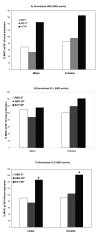The effect of hip abduction on the EMG activity of vastus medialis obliquus, vastus lateralis longus and vastus lateralis obliquus in healthy subjects
- PMID: 16817971
- PMCID: PMC1562433
- DOI: 10.1186/1743-0003-3-13
The effect of hip abduction on the EMG activity of vastus medialis obliquus, vastus lateralis longus and vastus lateralis obliquus in healthy subjects
Abstract
Study design: Controlled laboratory study.
Objectives: The purposes of this paper were to investigate (d) whether vastus medialis obliquus (VMO), vastus lateralis longus (VLL) and vastus lateralis obliquus (VLO) EMG activity can be influenced by hip abduction performed by healthy subjects.
Background: Some clinicians contraindicate hip abduction for patellofemoral patients (with) based on the premise that hip abduction could facilitate the VLL muscle activation leading to a VLL and VMO imbalance
Methods and measures: Twenty-one clinically healthy subjects were involved in the study, 10 women and 11 men (aged X = 23.3 +/- 2.9). The EMG signals were collected using a computerized EMG VIKING II, with 8 channels and three pairs of surface electrodes. EMG activity was obtained from MVIC knee extension at 90 degrees of flexion in a seated position and MVIC hip abduction at 0 degrees and 30 degrees with patients in side-lying position with the knee in full extension. The data were normalized in the MVIC knee extension at 50 degrees of flexion in a seated position, and were submitted to ANOVA test with subsequent application of the Bonferroni multiple comparisons analysis test. The level of significance was defined as p < or = 0.05.
Results: The VLO muscle demonstrated a similar pattern to the VMO muscle showing higher EMG activity in MVIC knee extension at 90 degrees of flexion compared with MVIC hip abduction at 0 degrees and 30 degrees of abduction for male (p < 0.0007) and MVIC hip abduction at 0 degrees of abduction for female subjects (p < 0.02196). There were no statistically significant differences in the VLL EMG activity among the three sets of exercises tested.
Conclusion: The results showed that no selective EMG activation was observed when comparison was made between the VMO, VLL and VLO muscles while performing MVIC hip abduction at 0 degrees and 30 degrees of abduction and MVIC knee extension at 90 degrees of flexion in both male and female subjects. Our findings demonstrate that hip abduction do not facilitated VLL and VLO activity in relation to the VMO, however, this study included only healthy subjects performing maximum voluntary isometric contraction contractions, therefore much remains to be discovered by future research.
Figures





Similar articles
-
Analysis on the activation of the VMO and VLL muscles during semisquat exercises with and without hip adduction in individuals with patellofemoral pain syndrome.J Electromyogr Kinesiol. 2005 Dec;15(6):596-603. doi: 10.1016/j.jelekin.2005.03.001. J Electromyogr Kinesiol. 2005. PMID: 15878289 Clinical Trial.
-
Vastus medialis obliquus and vastus lateralis activity in open and closed kinetic chain exercises in patients with patellofemoral pain syndrome: an electromyographic study.Arch Phys Med Rehabil. 2001 Oct;82(10):1441-5. doi: 10.1053/apmr.2001.26252. Arch Phys Med Rehabil. 2001. PMID: 11588751
-
Delayed vastus medialis obliquus to vastus lateralis onset timing contributes to the development of patellofemoral pain in previously healthy men: a prospective study.Am J Sports Med. 2009 Jun;37(6):1099-105. doi: 10.1177/0363546508331135. Epub 2009 Mar 12. Am J Sports Med. 2009. PMID: 19282508
-
Myoelectric manifestations of fatigue in vastus lateralis, medialis obliquus and medialis longus muscles.J Electromyogr Kinesiol. 2008 Dec;18(6):1032-7. doi: 10.1016/j.jelekin.2007.05.008. Epub 2007 Jul 17. J Electromyogr Kinesiol. 2008. PMID: 17644358
-
The effect of hip position and electromyographic biofeedback training on the vastus medialis oblique: vastus lateralis ratio.J Athl Train. 1999 Oct;34(4):342-6. J Athl Train. 1999. PMID: 16558584 Free PMC article.
Cited by
-
The effects of squatting with visual feedback on the muscle activation of the vastus medialis oblique and the vastus lateralis in young adults with an increased quadriceps angle.J Phys Ther Sci. 2015 May;27(5):1507-10. doi: 10.1589/jpts.27.1507. Epub 2015 May 26. J Phys Ther Sci. 2015. PMID: 26157251 Free PMC article.
-
Electromyographic analysis of hip and knee muscles during specific exercise movements in females with patellofemoral pain syndrome: An observational study.Medicine (Baltimore). 2018 Jul;97(28):e11424. doi: 10.1097/MD.0000000000011424. Medicine (Baltimore). 2018. PMID: 29995792 Free PMC article.
References
-
- Dye SF. The pathophysiology of patellofemoral pain. Presented at 48th Annual National Athletic Trainers Association Meeting; June 19, 1997; Salt Lake City, US.
-
- Wilk KE, Reinold MM. Principles of patellofemoral rehabilitation. Sports Medicine and Arthroscopy Review. 2001;9:325–36. doi: 10.1097/00132585-200110000-00010. - DOI
-
- Stokes M, Young A. Investigation of quadriceps inhibition: implications for clinical practice. Physiotherapy. 1984;70:425–28.
LinkOut - more resources
Full Text Sources

